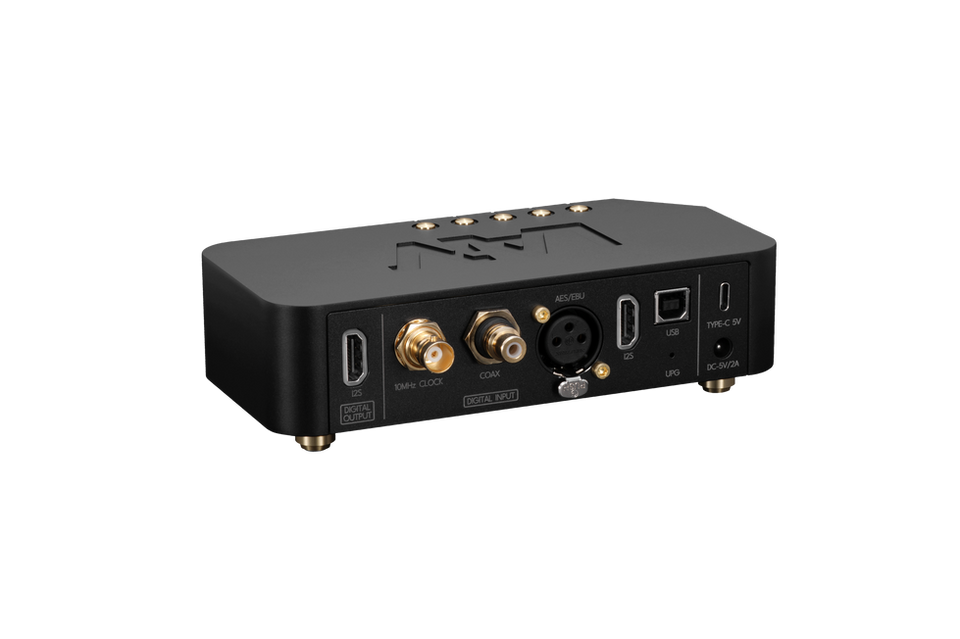Harmony µDDC
READY STOCK - Ships out in 2–3 business days with free worldwide shipping. Estimated delivery time is 10–14 business days.
The Harmony µDDC is a high-performance digital-to-digital converter designed to elevate your audio experience. Equipped with advanced reclocking technology, it reduces jitter and ensures a cleaner, more precise digital signal for your DAC. Supporting multiple input formats and offering high-quality I2S output via HDMI, the Harmony µDDC seamlessly integrates into any high-end audio system.Compact, versatile, and engineered for excellence, the Harmony µDDC is the perfect addition to unlock the full potential of your digital music.
Quantity
Highlights
Precision Femto Clock
-
Ultra-low jitter ensures pristine timing accuracy for superior audio clarity and detail.
Versatile I²S Inputs and Outputs
-
Input: High-performance USB, AES/EBU, Coax I²S input with pinout configuration.
-
Output: Galvanically isolated I²S outputs for uncompromised signal purity and reduced noise.
High Sampling Rate Support
-
PCM: Supports resolutions up to 768kHz*
-
DSD: Handles formats up to DSD512*
External Master Clock Input
-
Seamless integration with an external 10MHz master clock for precision synchronization.
*For USB and I²S inputs only.
Please check out the product overview and tech specs for more details: https://www.laiv.audio/harmony-uddc
















Reviews
I just received my reclocker from LAIV Audio and the first impressions after listening to it are outstanding!
Both my streamer (a Lumin U1 mini) and my CD transport (Audiolab 9000 CDT) sound definitely better with the reclocker connected to the Denafrips Pontus II DAC.
Really an excellent product!
I now own the Harmony uDAC + uDDC from Laiv audio with Eversolo A6 as a transport with the upgraded power supply. Plus Ladder Chopin preamp: Zidoo A 400 power amp with very modest bookshelf speakers from Triangle (with which I will eventually upgrade) to prove that you don't have to spend huge money for great sound.Since the addition of the Laiv audio Dac/uDDC my modest system has transformed. While listening to one of my all time favorite artists I was brought to tears, the performance was so heart felt. I've had far more expensive systems that haven't connected me to my beloved music in this way before.My purchace of the Harmony products has been the icing on the cake.The realistic size of the sound stage and the dark naturally realistic back ground with which the music appears from along with the accuracy, transparency and timbre of voice and instruments is uncanny. Wish my old very expensive rig did that for me like this new system does. I will not hesitate to purchase more products from Laiv in the future.This Dac/reclocker combo has truely transformed my modest system into an ultra clear window of realistic sound. Reviewers say the difference is subtle when UDDC is added to the uDac but to me even with not the most revealing speakers is very noticable and worth every dollar spent.
Thank you Laiv audio for the wonderfully life like sounding products your very capable team of engineers has built.VERY IMPRESSED!
Six months ago, I obtained the LAIV Harmony uDAC and as my Harmony website reviews reveal, was extremely pleased with the sonic gains in my 2-channel system…just could not imagine my audio nirvana any better. 3 days before the LAIV Harmony uDDC Reclocker arrived, I installed sub cabinet isolators. Post sub-isolators, my system has Never sounded better! Anticipation as to how/what the Harmony uDDC Reclocker could offer my already fine-tuned, half-century in the making, jaw dropping sound reproduction setup.
With 100 hour uDDC break-in recommendation, I started 24 hours “round the clock” with various music playback genre and to my ears, it really needed it! During the break-in period, I spent 3-4 hour listening sessions each day comparing my previous direct uDAC sonics to the newly inserted system uDDC reclocker…was not impressed during those first 100 hours, I had resigned myself to returning this unit (top end not close to what I had previously achieved). But, recalling that my uDAC took 250 hours to really open-up and shine synergisticly in my system, I opted to continue (with much patience), the break-in process. After all, still had 56 days left to the LAIV Audio return window!
To get fully settled in to its potential system position (equaling then surpassing the open and deep soundstage presentation, very airy vocal, instrumental, keyboard, string, percussion imaging that I had assembled before the uDDC), took more like 225+ hours! Bass authority, speed, timing, tonality, timbre, and depth did arrive, and elevate bottom end performance within the first 25 hours! The rest of the midrange and treble openness, air and immediacy in transient response, articulation, and precise tonality, took a full extra 200 hours! Now, the full bandwidth plays effortlessly in what feels like perfect timing and presence. The system breathes, space and air between notes comes alive, and music flows with more feeling and emotional involvement, rather than just listening to a great stereo!
Has the uDDC greatly surpassed what I heard before its arrival? No, not with my system, my dedicated music room, my acoustic genre music library, and to my 25 years’ experience in a previous music career (private study, degree, performance, and teaching)! However, it has presented to my ears subtle but definitive sonic realism and growth, with blissful enjoyment as the setup and room disappear! The music unfolds in front of me, and I Am There in the recorded venue with the musicians!!